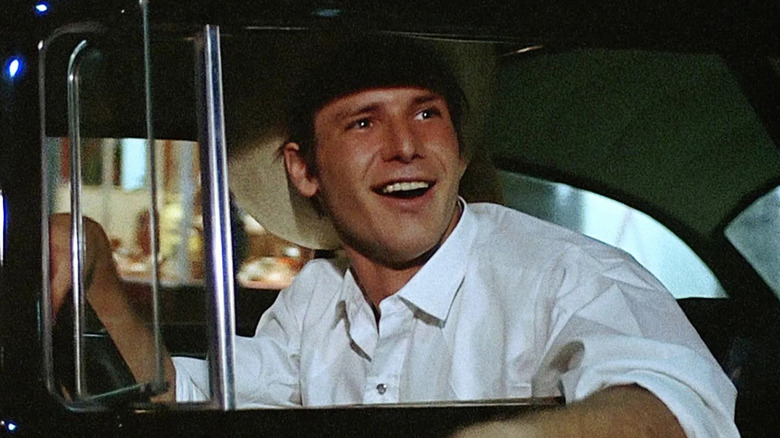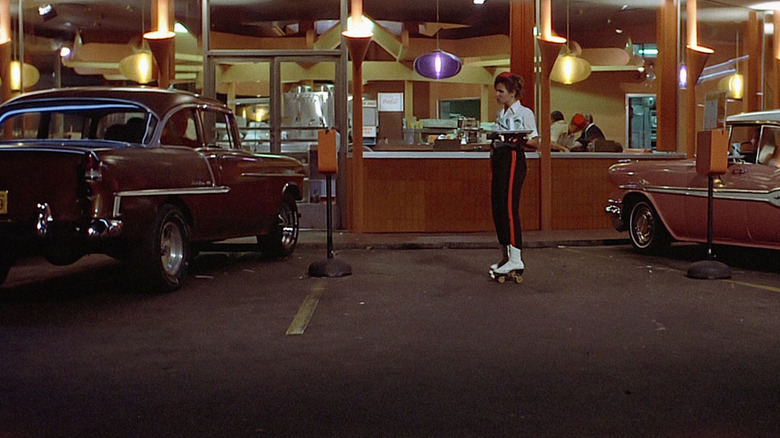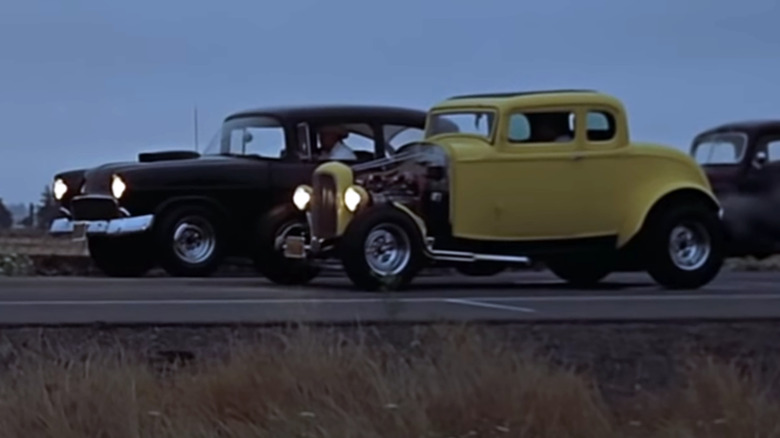George Lucas Made American Graffiti A Career First For Harrison Ford
Before traversing the galaxy in the Millennium Falcon, Harrison Ford cruised the strip around Modesto, California, in his '55 Chevy in George Lucas's coming-of-age dramedy "American Graffiti." It was something of a breakout role for Ford, who managed to make the drag racing cowboy Bob Falfa stand out in a relatively short amount of screen time. Ford turned 30 during filming, and had already been put through the cookie cutter machine of the Hollywood system. Appearing in bit parts on shows like "The F.B.I." to little fanfare, Ford became a carpenter to the stars, even building a recording studio for bossa nova legend Sergio Mendes. Embittered by his experiences as a performer, Ford still had the acting bug in his blood, though. His father was a radio actor and ad man from Chicago — and his grandfather was a vaudevillian.
But no matter what Ford tried, he just wasn't getting noticed. He was making $150 a week acting. After landing a small role in Francis Ford Coppola's "The Conversation," producer Fred Roos suggested Ford for the role of Bob Falfa to George Lucas, who was also considering Cindy Williams from Coppola's film. (Williams would go on to star as Laurie in "American Graffiti.") Obviously, the combination of Ford and Lucas helped to usher in the modern blockbuster and created a different, more relatable action hero archetype.
The surprise success of "American Graffiti" launched Ford's career and solidified Lucas as a capable mainstream filmmaker after "THX 1138." It was also the first time Ford was allowed to collaborate with his director. The movie was largely autobiographical, and it remains the most personal film of Lucas's career. The suggestions by Ford made the story about the last night of high school a little more true-to-life, helping Lucas deliver a classic.
A crew cut or a cowboy hat
The small town rivalry between the hip dragster John Milner (Paul Le Mat) and Harrison Ford's cocky Bob Falfa starts out as a fun subplot in "American Graffiti" but winds up being the emotional crossroads of some of the major characters after their final race at dawn on Paradise road ends in a brutal accident. Growing up, George Lucas knew guys like Milner and Falfa, and Ford added a big detail that tapped into the director's own personal memories of some of the kids that cruised the strip in his hometown of Modesto, California. In a 2019 interview with Empire, Ford remembered how important it was for Lucas to actually respect his opinion. "'American Graffiti' was the first movie where the director let me have any input," he said. "It was the first time anyone ever listened to me."
After being forced to wear a pompadour like Elvis Presley in his early acting days, Ford disagreed with the clean cut look Lucas wanted for Falfa, and offered up a simple solution that ended up defining the character:
"George thought my character should have a crew cut, but I wasn't happy with that idea. I'd always had pretty long hair back then, in college, particularly, so I told George my character should wear a cowboy hat. George thought about it and he remembered a bunch of guys from Modesto, California, who cruised around, like my character, and wore cowboy hats, so it turned out that it actually fit the movie."
A crew cut would still have made Ford look like someone who would never associate with a free-wheeling rebel like John Milner, but the cowboy hat conveys the same thing. These two are rivals that don't look alike. They respect each other, but they would never hang out together.
George Lucas's most personal film
When George Lucas was growing up in Modesto, he was much more into fast cars than making movies. His dad, George Sr., bought him a yellow Autobianchi Bianchina with a two-cylinder engine that Lucas quickly ramped up by tuning up the engine and installing a racing belt. In the book "George Lucas: A Life," biographer Brian Jay Jones offers up a breakdown of the moment when the young dragster's life flashed before his eyes.
After a night out on the strip, a Chevy Impala came out of nowhere and smashed into Lucas, sending his car flying through the air where it eventually smashed into a walnut tree. If the racing belt Lucas installed hadn't snapped, he would've been crushed. He did suffer major internal injuries with several broken bones and bruised lungs. The year was 1962, the same year that "American Graffiti" is set.
Lucas was in the hospital for months, where he made the decision to stop pursuing racing. The car culture that he loves is displayed most prominently in "American Graffiti," and the wreck at the end that changes the directions of so many lives mirrors his own harrowing experience. From the Kessel Run that Han Solo boasts about in "A New Hope" to the podracing sequence in "The Phantom Menace," the lifelong love of racing continues to be a big part of Lucas's filmography all these years later. But it's "American Graffiti" that is truly his most personal film and a love letter to a more innocent, pre-Vietnam era in America.


